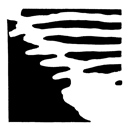Recently featured at La Piscine Museum in Roubaix and Galerie de l’Ancienne Poste in Toucy (Burgundy), Laurent Petit revealed a universe that embraces at once history, mythologies and the plant realm. He works in series, questioning human nature as much as the nature that surrounds us.
Born in 1962 and trained at the École Nationale Supérieure des Arts Décoratifs in Paris, Laurent Petit gradually let himself be won over by his material as he granted it increasing freedom. An industrial designer at first, he acquainted himself with clay during a raku course in 1992, followed up with training at Maison de la Céramique in Mulhouse.
His corpus began with the series Presque-Objets, developed from 2002 to 2006, in which former vessels or everyday references can be identified, strung out in shades of ochre and white. They are viewed by the artist as somewhat unlikely utensils transformed by the passing of time, in relation to archaeology and the memory of ancient civilizations. These emergences of a controlled past led him, during the two years that followed, towards what he named Elébuxes, Cruciles and Lutrondes. Assigned with remote Latin sounds made up by the artist, these works affirm his attention to antique sculpture or the resurgence of it preserved in his memory. Playing on the imbalance between solid forms, flat tints – the latter term being a deliberate reference to the pictorial medium – and stalks rising in a precarious stability, they evoke museum statuaries having lost their heads, crossed with Paolo Uccello’s The Battle of San Romano or Cy Twombly’s influence. “As a creator, Laurent Petit begins, you are often a prisoner of your memory, even the one you have forgotten.”
Regarding his technique, though Laurent Petit may have used a wheel during his first years, he has since been combining moulding and modelling for over fifteen years with a great deal of freedom. He likes to emphasize the distortions and transformations as the different parts come out of the mould, changing their meanings over and over. A glaze and enamel slip is applied on the stoneware made up of stamped pieces, while others may be modelled from a slab. At the centre of a very introspective practice, Territoires intérieurs stretch out from 2010 to 2014 alongside Arbologies, developed until 2017. The ambivalence of interpretation here lies in the connection between plants and the human body. Laurent Petit oscillates between the object, its figuration and abstraction. The ten-year span of this series clearly allows a variety of its perspectives to be shown while elements related to branches still arise in his current productions, which do not focus on reinterpreting the history of the landscape but attest to time diligently spent in the studio. It was actually the wish to cast boxwood branches that led him to work around trunks or leaves. “It was a search for reconstructing the plant, he continues, and my Arbologies seem like a regrowth from a body whose upper part would have been severed, evoking grief as much as the possibility of revival.” They do give the impression of a new element rising out of the clay mass, a balance being generated within the struggle and leading to the series Vestiges, from 2017 to 2019, and Elégances du chaos, from 2018 to 2019.
Those years are of great importance in Laurent Petit’s creation, which took a real turn in 2016 after he discovered Cy Twombly’s canvasses exhibited at the Brandhorst Museum in Munich. The ceramic artist can certainly list more pictorial references such as Zao Wou-Ki, Hans Hartung, Pierre Soulages or Joan Mitchell. Yet he particularly admires in the American-born plastic artist what art critics called “coded emotional releases” and the relation to naval battle, of which he gave his own version. This tension thus appears particularly in Elégances du chaos, where vertical or horizontal lines deconstruct the notion of grid and brace against solids that might represent collapsing rocks. This is what Laurent Petit set out to work on, from this quest for balance to the famous weakness of Achilles, in his most recent series named Mythologies, although he simultaneously refutes an exclusively conceptual approach of his work and always puts the emphasis on the material. In this specific instance, it was a plaster cast that led him to moulding a piece of wood, a stone, then a leaf, thus allowing his mind to wander towards antique armours and battles, and to the hero of the Trojan war. It is clearly perceived that the notions of vestiges, fossilized objects or bodies, but also the passing on and erasing of memory are continuously developed by the artist.
Laurent Petit always brings the peculiar and very structured vision of an architect’s eye, or a former industrial designer’s, into the field of ceramics. He admires sculptors who nurture their ratio between solids and voids, such as David Nash, Tony Cragg and John Chamberlain. When he started out, he also observed Gordon Baldwin for his use of white and the great freedom with which he combined cast and modelled parts. Laurent Petit’s artwork thus aspires to be pictorial and always in relation to its surrounding space. “As a counterpoint to the coloured areas of my works, he concludes, white brings me neutrality and calmness. The matt and glossy finishes are metaphors on the difference between the active memory and the more fleeting recollections, or how to allow the two notions to live side by side…”
Marie Maertens – Critique d’art et curator
Translated by Marina Duval Matthews


